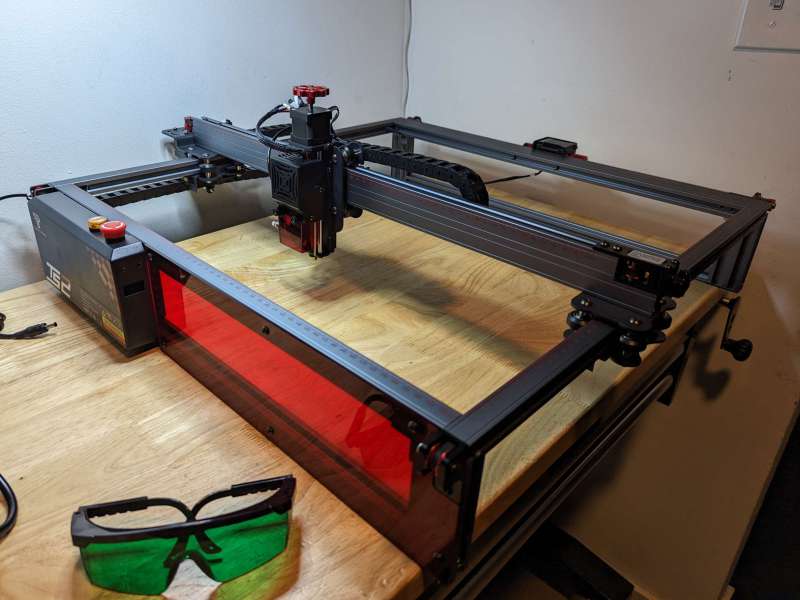
REVIEW – While 3D printers have gotten more popular as prices have come down and the technology has advanced I haven’t seen quite the same rise in the popularity of laser engravers. As more affordable and versatile engravers hit the market though their popularity might be catching up to that of their 3D printing cousins. Finally getting the chance to try out this exciting technology myself, I was happy to review the TwoTrees TS2 10W Diode Laser Engraver.
The TS2 has a lot of great features not found on most laser engravers in its class and despite some assembly frustration, the unit performed really well in testing. The price is a bit high at $569 but is justified by all the extra features built into the unit.
What is it?
The TwoTrees TS2 10W Diode Laser Engraver is a versatile laser cutter and engraver with a large 450mm by 450mm working area and a powerful 10W auto-focusing laser. The TS2 ships partially assembled but does require significant assembly and calibration before use. The TS2 has several built-in safety features like protective eye shielding around the laser and along one side of the unit. The TS2 also has a fire detector, emergency stop, and internal gyroscope that can disable the laser in case of tipping.
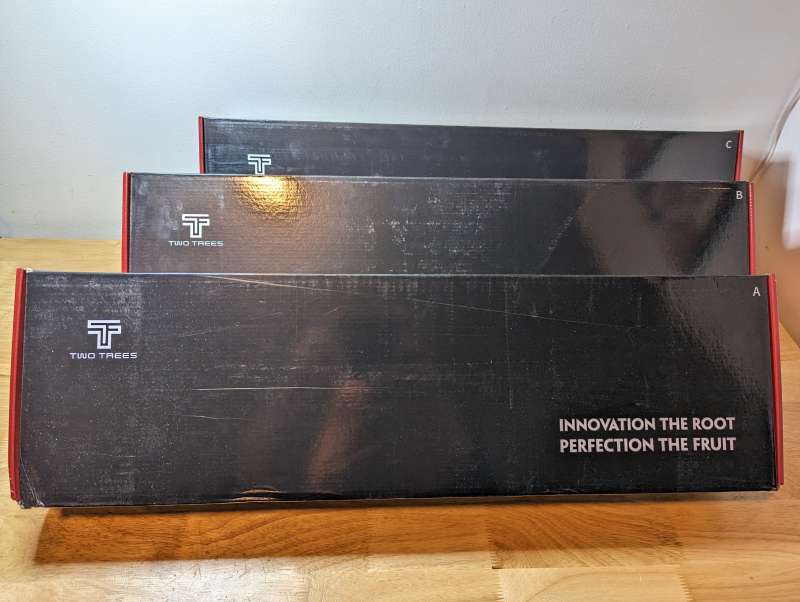
The TwoTrees TS2 laser engraver ships in three nondescript boxes featuring the TwoTrees logo and labeled A, B, and C.
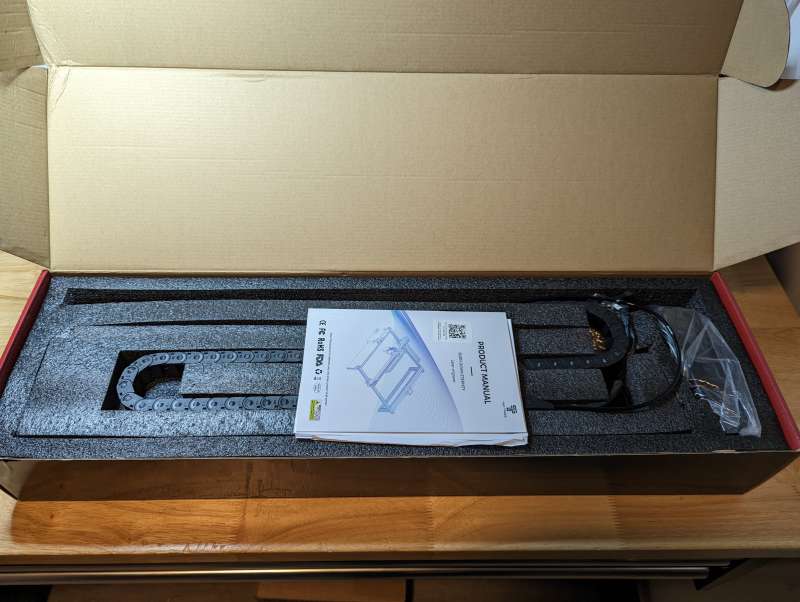
The boxes contain the different sides of the TS2’s frame packed into thick foam. While this seems like it would protect the unit from damage, my unit had a severed connection on a particularly weak solder point, but more on that later.
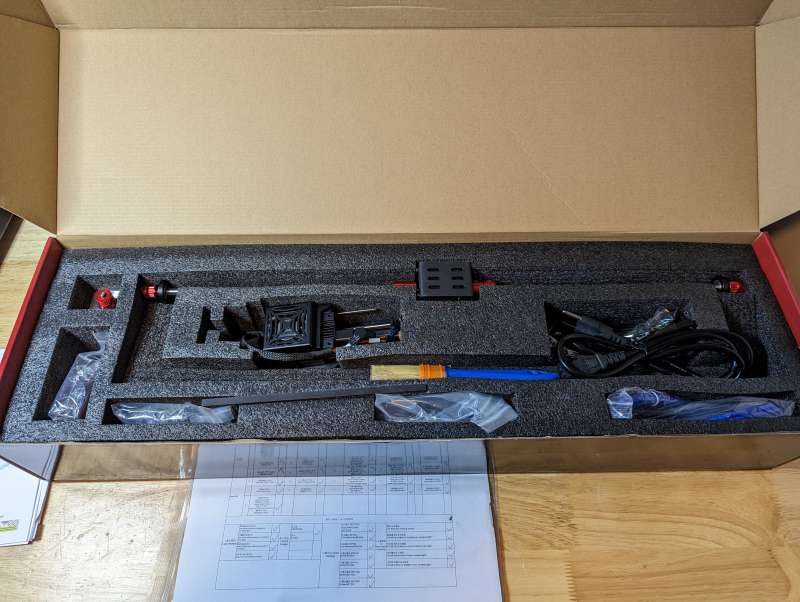
What’s in the box?
- TwoTrees TS2 10W Diode Laser Engraver Parts
- Front Frame
- Y-Axis Left Frame
- Y-Axis Right Frame
- Back Frame
- X-Axis Stepper Motor
- X-Axis Crossbeam
- Laser Module
- Frame screws and bolts
- USB-A cable
- Power adapter and cable
- Tool Kit
- Safety Glasses
- Instruction Manual
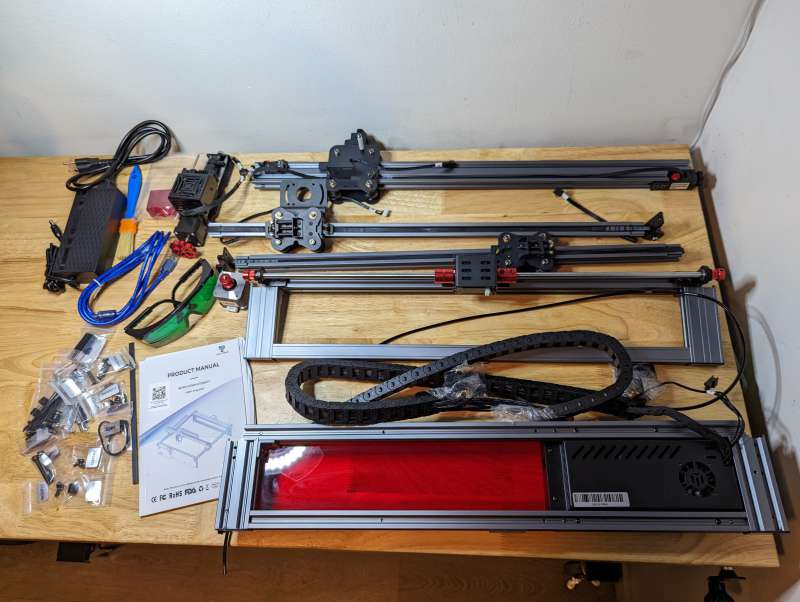
Hardware specs
- Laser Power: 10W (10000mw)
- Laser Type: Auto-focusing Diode
- Laser Spot Diameter: .08mm x .08mm
- Cutting Depth: ~15mm
- Sintering Temperature: 2192°F (1200°C)
- Processor: 32 bit LX6
- Laser Wavelength: 445±5nm
- Engraving Speed: 10000 mm/min
- Electrical Requirement: 24V 4A DC
- Engraving Area: 17.7 x 17.7in. (450 x 450mm)
- Machine Size: 28.86 x 28.39 x 6.77in. (733 x 721 x 172mm)
- Machine weight: 14lb (6.5kg)
- Engraving Method: USB to Computer, Wirelessly via App, or Internal Micro SD Card
- Engraving Modes:
- Image Carving
- Text Carving
- Scanning Carving
- Contour Carving
- File Formats: JPEG, BMP, GIF, PLT, PNG, HPGL, JPG, XJ, SVG, GCODE
- Supported Software:
- LaserGrbl
- LightBurn
- Software Systems Supported: Mac, Windows, and Linux
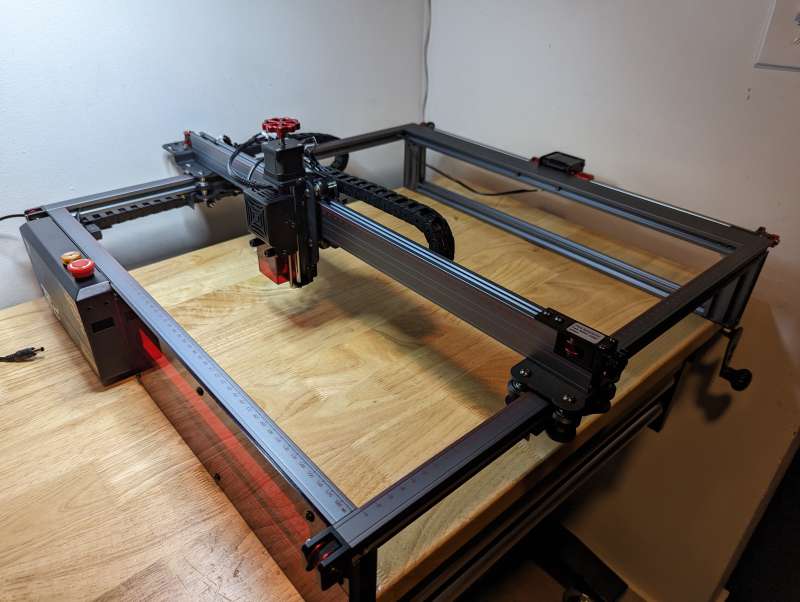
Design and features
The TwoTrees TS2 laser engraver has a similar design to most laser engravers with a few notable exceptions. The unit is made up mainly of a sturdy square frame with a movable gantry on top which holds the laser assembly. Overall the build quality of the TS2 is quite impressive with reinforced joints and premium metal parts used in the frame and assembly.
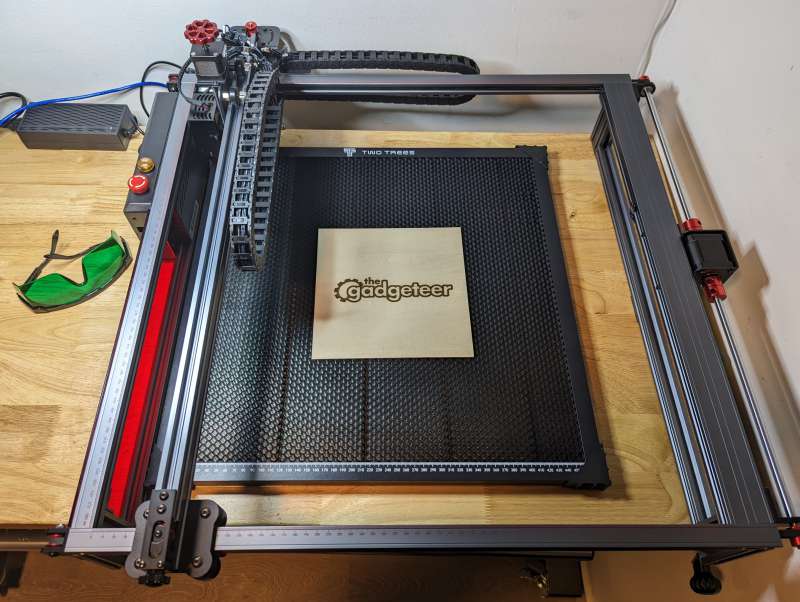
I have to note that most of my photos show the TwoTrees Honeycomb Laser Bed which is not included with the TS2. The laser bed prevents stray laser movement from damaging the surface of my workspace and the honeycomb design helps to cut down on smoke and burnt edges while cutting.
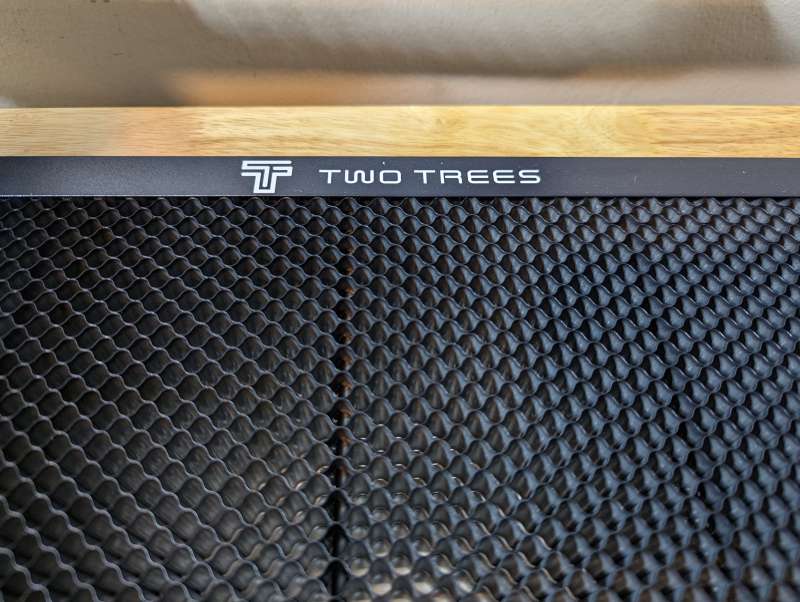
One great feature the TwoTrees TS2 laser engraver has that most laser engravers in its class do not is the manual focus knob located on top of the laser assembly. This large red anodized knob allows for precise adjustment of the laser head prior to operation.
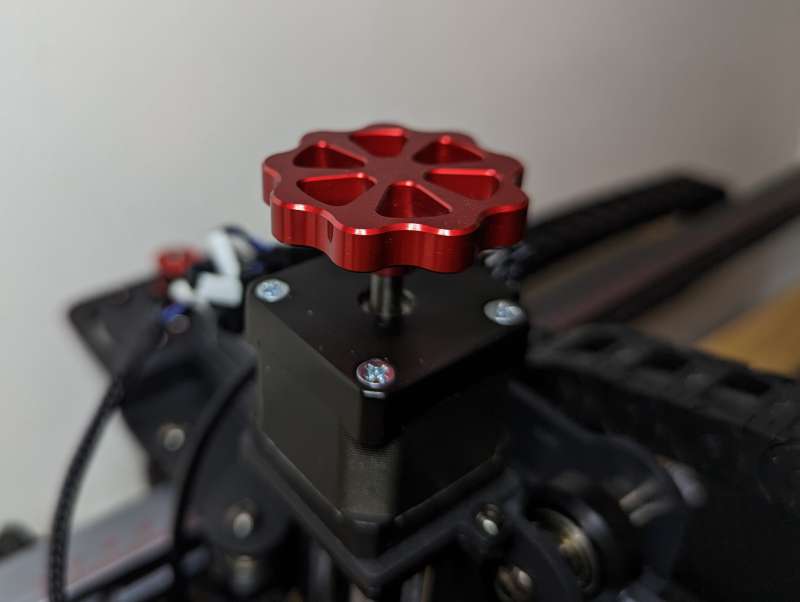
There are several other red anodized parts on the TS2 such as the adjustable sleeves along the axes and the tensioners. The red parts add to the high-quality feel of the TS2, pointing out areas that are adjustable and adding to the overall aesthetic of the unit.
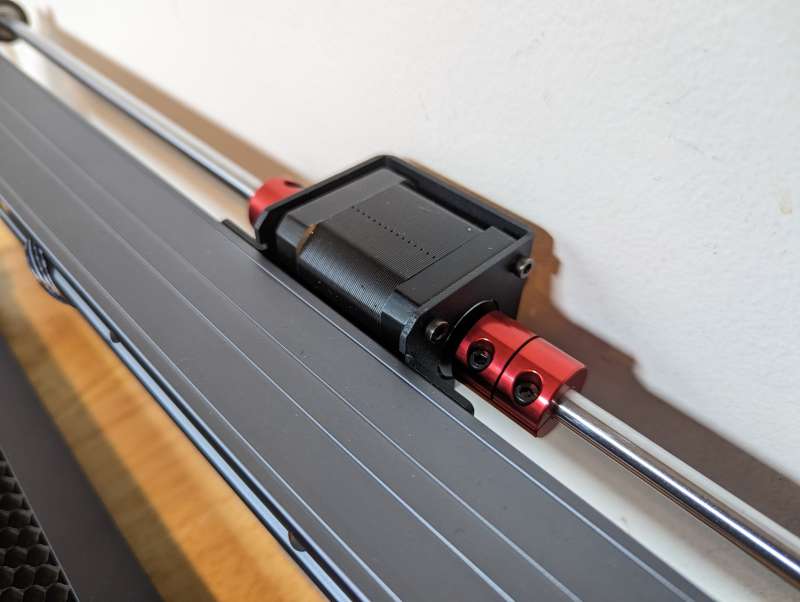
Another quality aspect of the TS2 is the protection of the wiring. All wiring is run internally along the axes protected by plastic cable carriers.
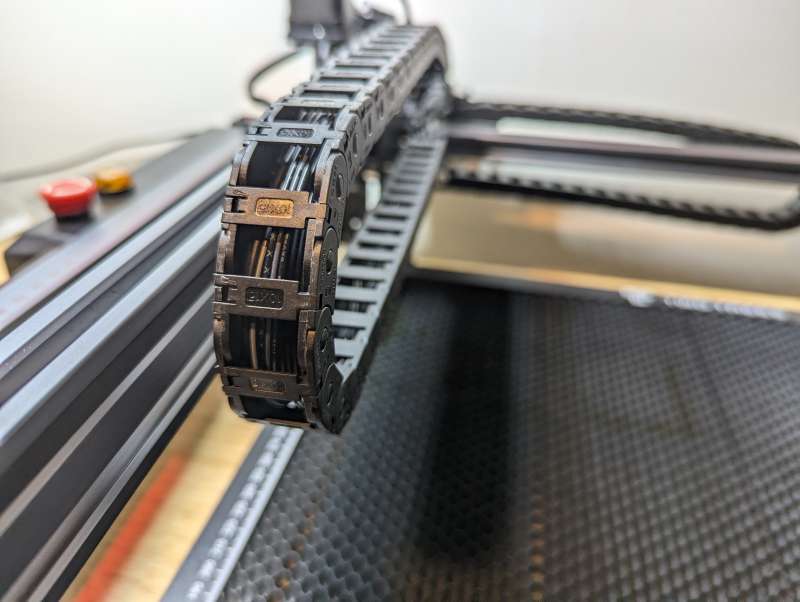
The biggest advantage the TwoTrees TS2 laser engraver has over other engravers though is the laser’s auto-focusing feature. A small metal pin runs alongside the laser and touches down on the material being used automatically adjusting the focus of the laser. This is such a huge help for someone like me who is new to the hobby and it’s worth the higher price of the TS2.
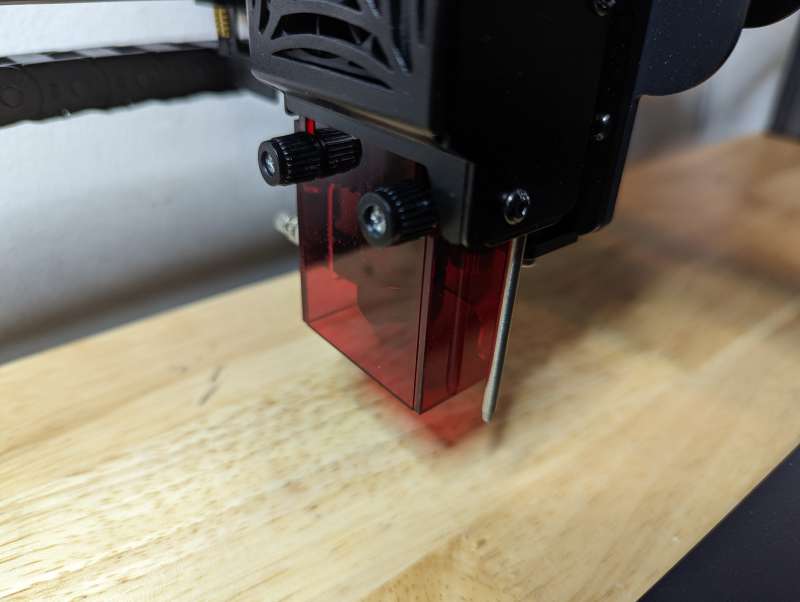
The TS2’s safety features also help to place it above most other similar engravers. The red shielded enclosure that surrounds the laser helps prevent eye damage.
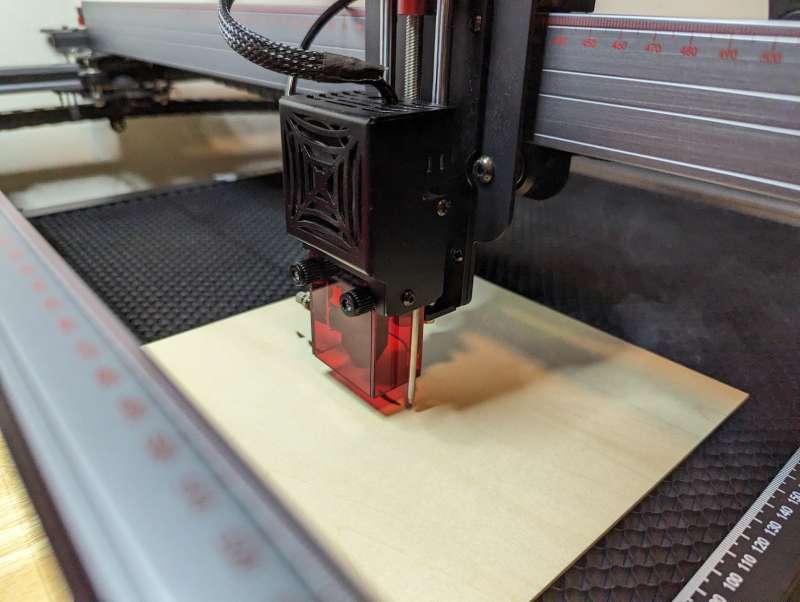
That same red shielding runs along the side of the unit where the controller is as well, allowing the user to watch the laser operate without fearing eye damage.
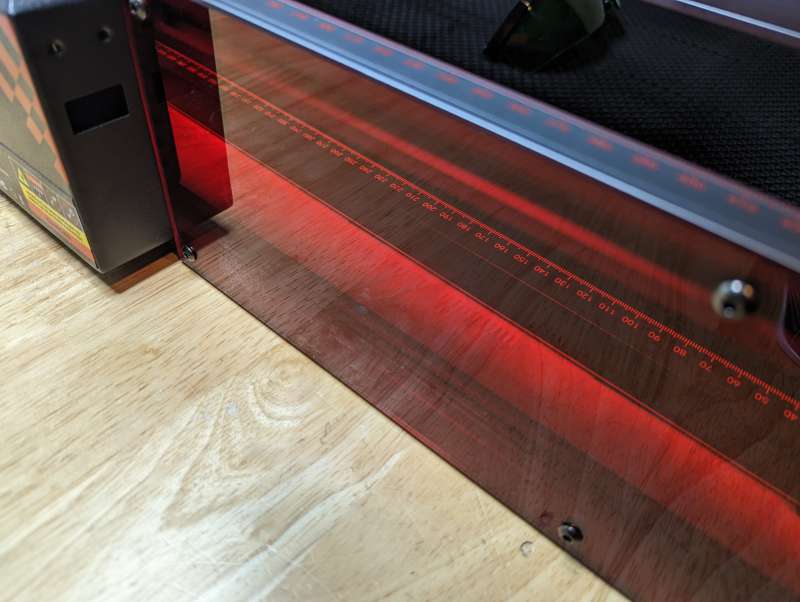
The red shielding alone isn’t enough protection though and safety glasses such as the ones provided with the TS2 should be worn at all times.

The TwoTrees TS2 laser engraver controller incorporates even more safety features. There’s an internal gyroscope that automatically stops the unit if it is tilted at an angle of more than 15°. This prevents the TS2 from continuing to operate if it falls off the work area. The TS2 will also automatically stop operating if the controller detects a laser head obstruction, preventing accidental extended laser output that could result in a fire.
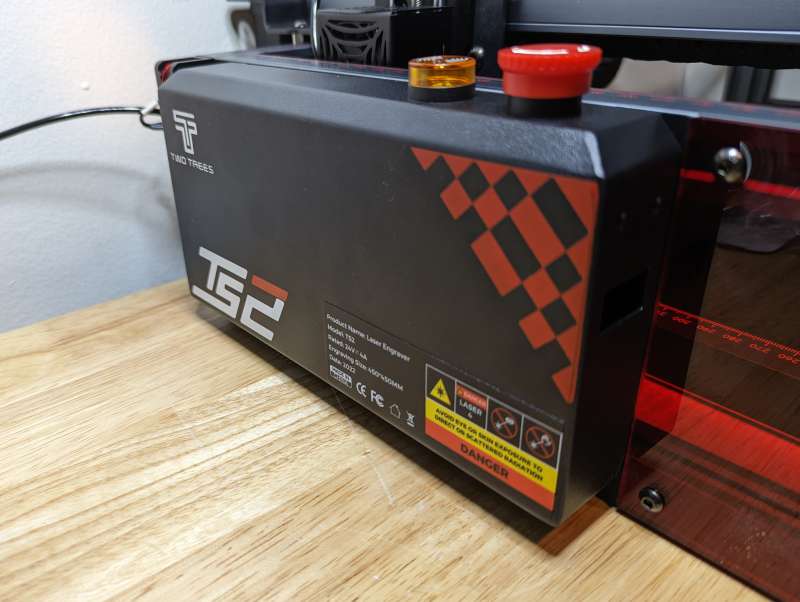
On top of the controller are the manual emergency stop button and the flame detector alarm. The large red emergency stop button can be engaged by pressing it down or hitting it, immediately cutting power to the TS2. The power can be turned back on by twisting the button clockwise, this button functions as a power switch as well. Next to the emergency stop button is the yellow flame detector alarm. This alarm activates if the small flame detector located next to the laser head detects fire or extensive smoke. The fire alarm goes off, the yellow light activates, and the TS2 is automatically shut down.
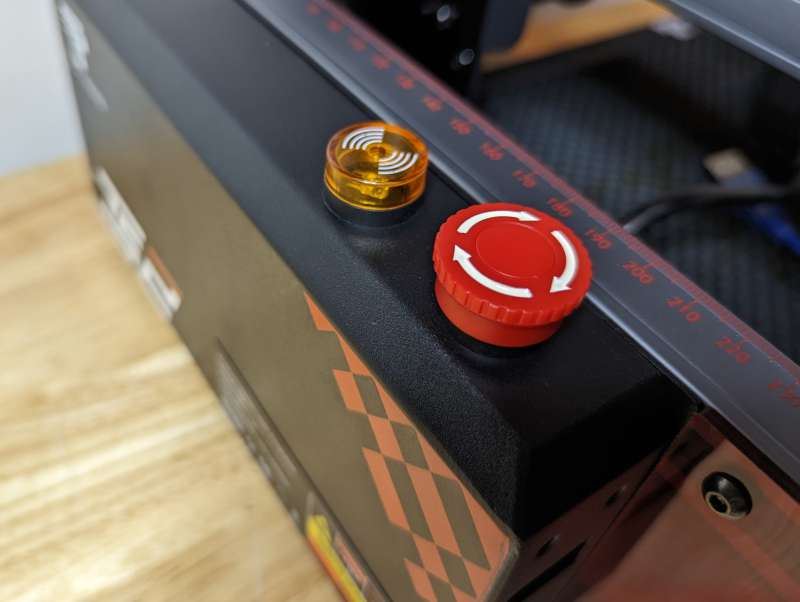
On the back of the controller are the connection ports for the TwoTrees TS2 laser engraver. There’s a 24V power port, a USB connection, and a MicroSD Card slot.
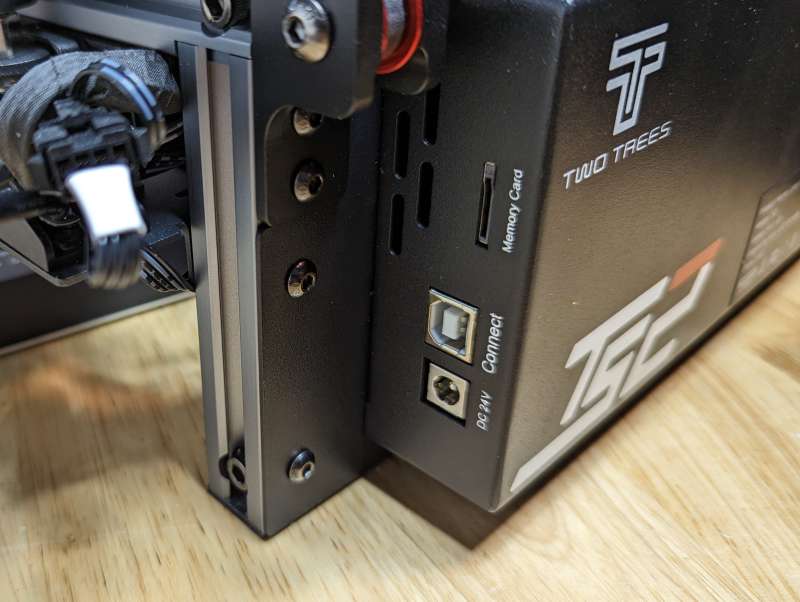
The TS2 ships with a standard power adapter and cable.
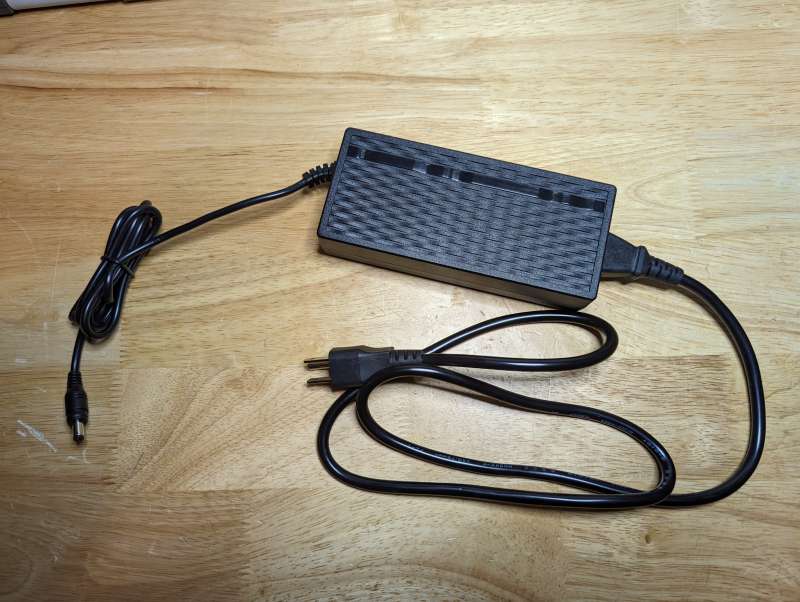
It also comes with a basic USB-A cable for connecting the TS2 to a computer.
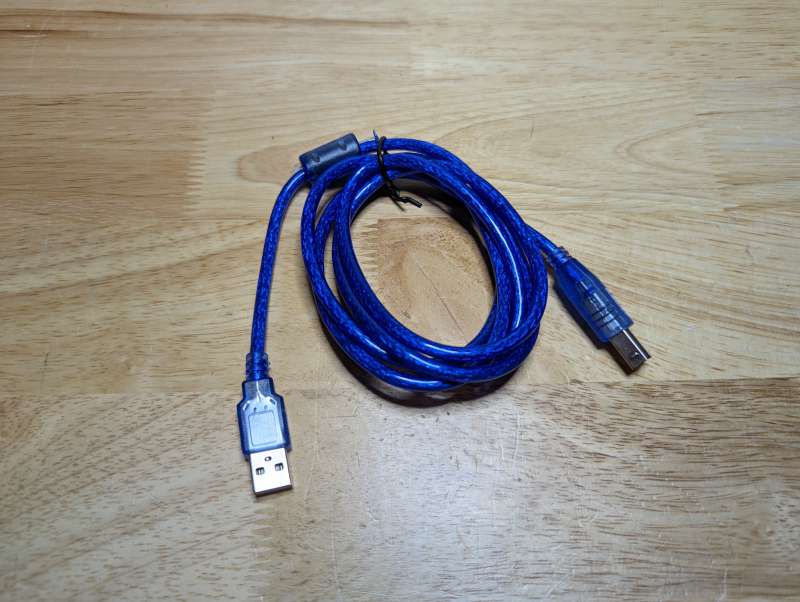
To aid in assembly there’s a tool kit included that has all of the Allen wrenches needed to put the TS2 together along with a standard wrench, flathead screwdriver, and cleaning brush.
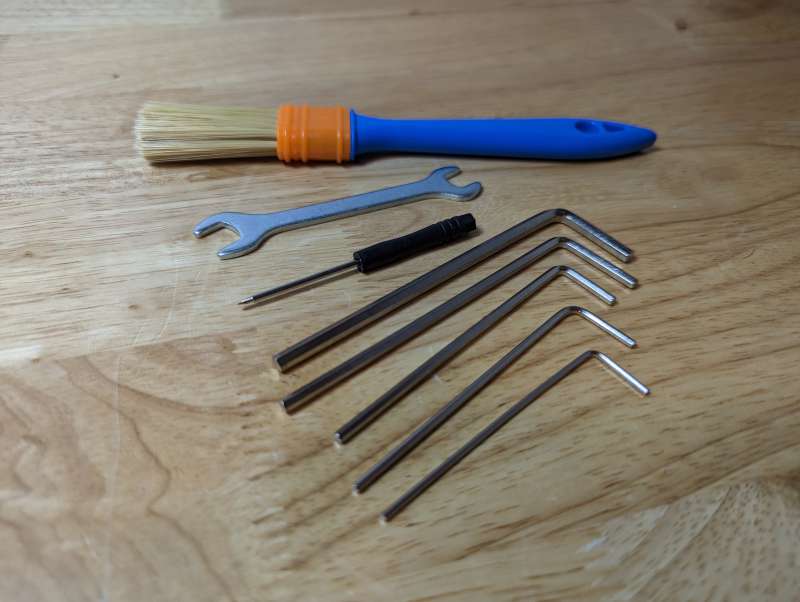
While the basic design of the TS2 doesn’t seem much different from most laser engravers, the extra details and features make it stand out from the crowd.
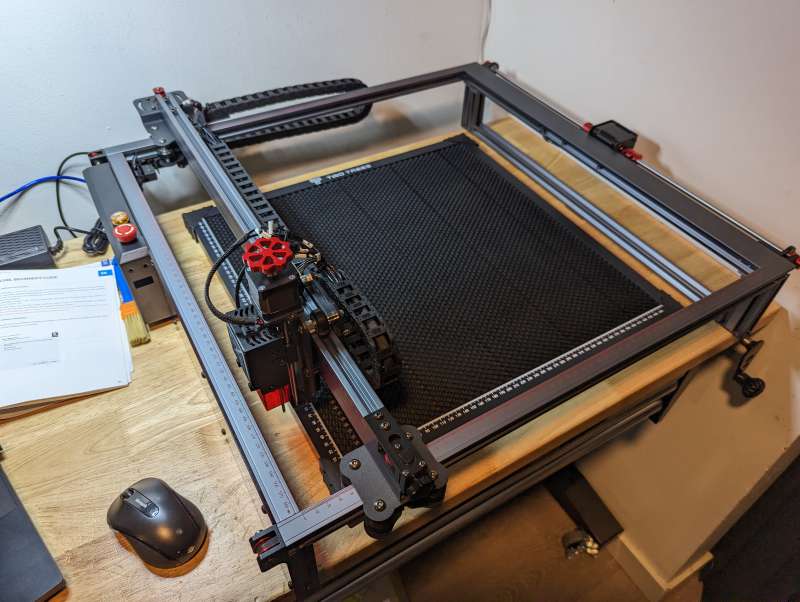
Setup
Setting up the TwoTrees TS2 laser engraver should be relatively easy since it ships partially assembled, unlike some other laser engravers. Ideally, this saves a lot of setup time since you aren’t putting together every single component of the unit. Unfortunately, the instructions for the TS2 are severely lacking in clarity and usefulness. I had to stop several times and disassemble a section of the TS2 only to have to reassemble it again because of confusing instructions.
Further complicating my assembly was the fact that my unit arrived with a broken connection on one of the axis limiters. A weak solder point failed and the tiny wire that tells the TS2 when the gantry has reached the end of one of the axes became disconnected.
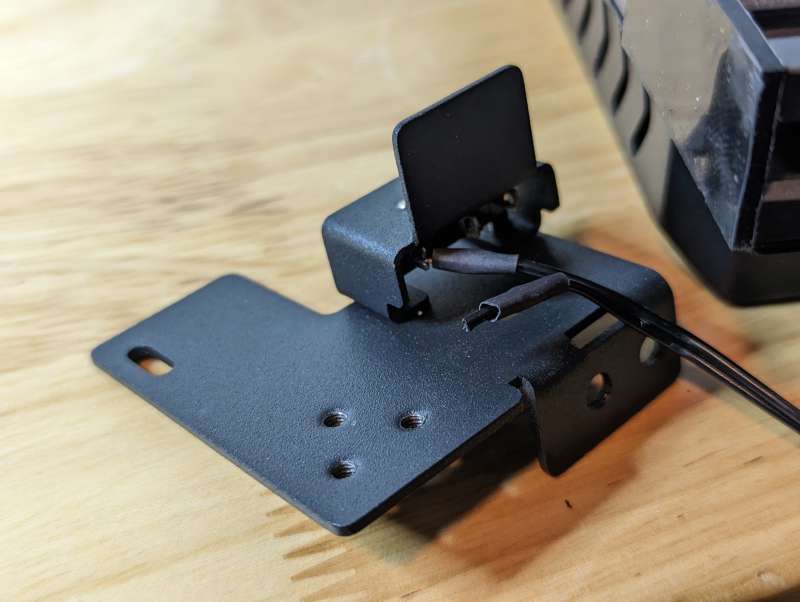
After taking the mount apart to access the solder point I was able to redo the connection with a stronger solder.
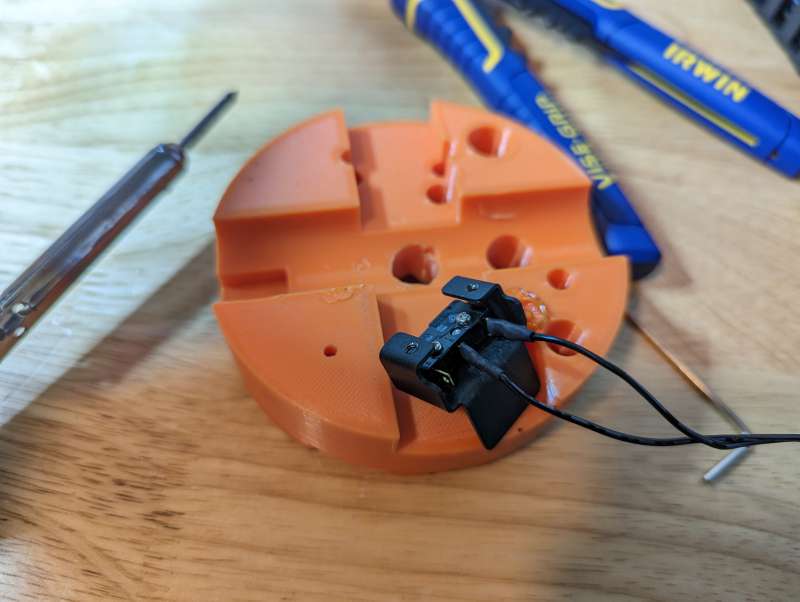
Once that repair was taken care of, the real work began, assembling the TS2’s frame. The frame edges lock together securely and are fastened with bolts.
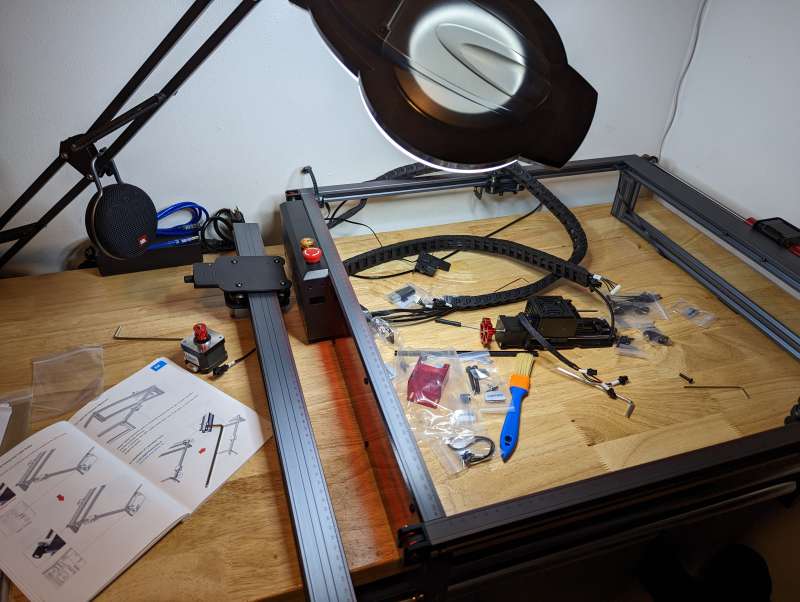
There’s a lot of calibrating that has to be done to make sure that the moving parts of the TS2 are always in perfect sync. This calibration can take some time and requires patience since tightening the bolts sometimes moves the parts out of alignment meaning you have to start over again.
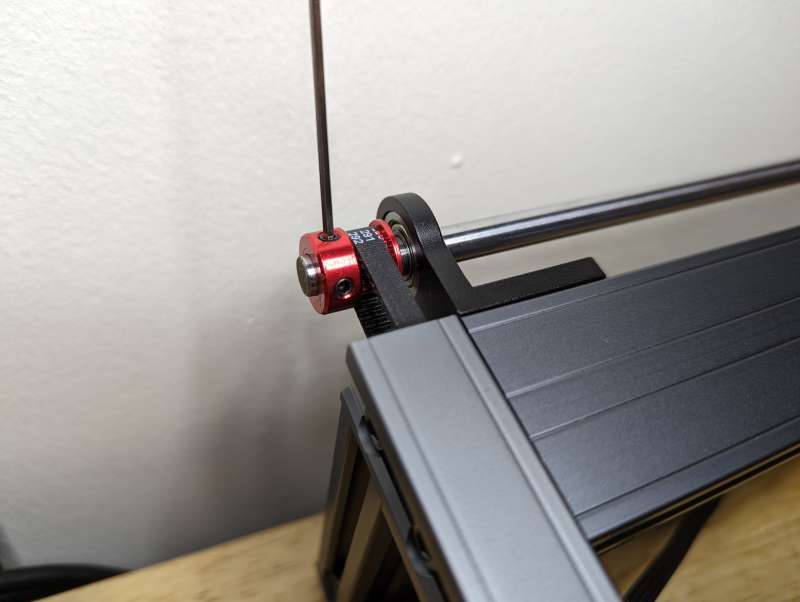
The rulers on the axes are invaluable in making sure everything is aligned correctly.
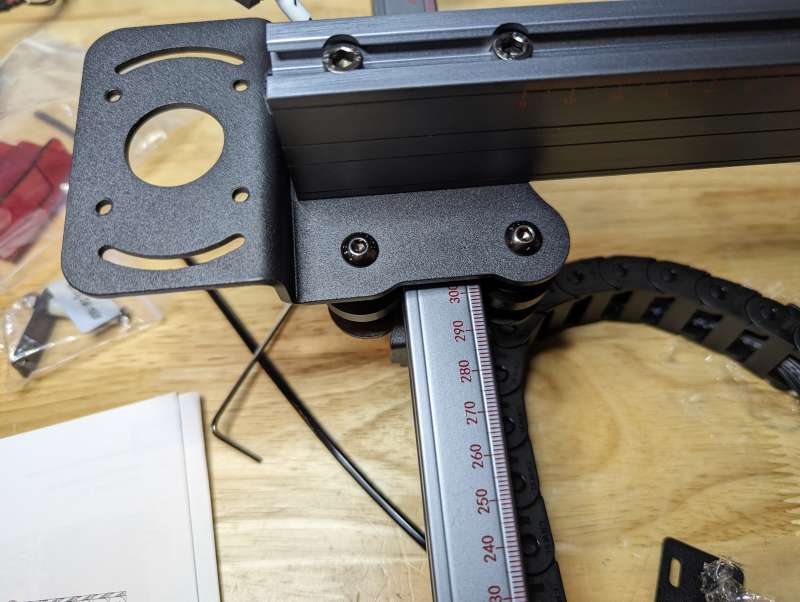
One of the most important pieces to attach to the frame correctly is the laser module. Luckily, the module comes pre-assembled so it just has to be secured to the gantry.
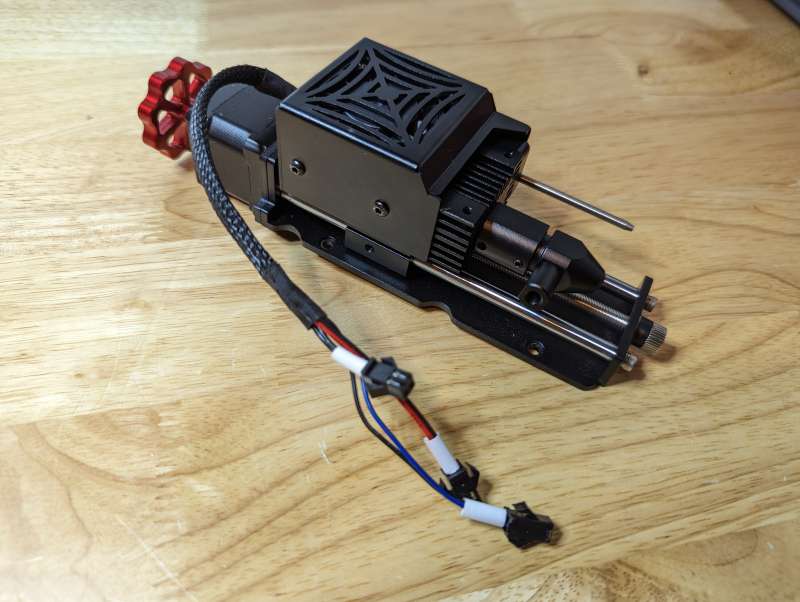
Once in place on the now perfectly aligned gantry, the laser module wiring has to be connected to the stepper motors. The connections are clearly labeled so it would be difficult to make an incorrect connection.
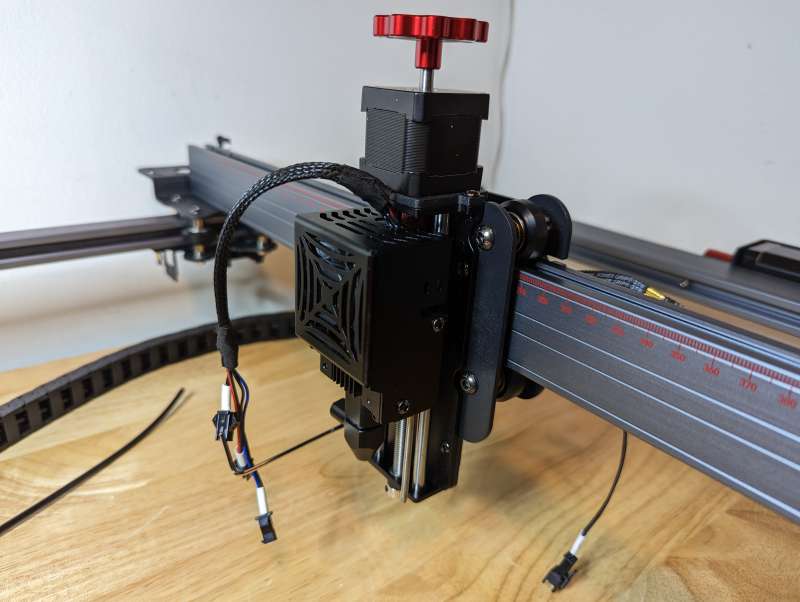
After the wires are connected to the correct plugs all that remains of the assembly is tightening the slack on the belts that move the gantry along the axes. This is made easy by the adjustable tensioner knob on the end of the gantry.
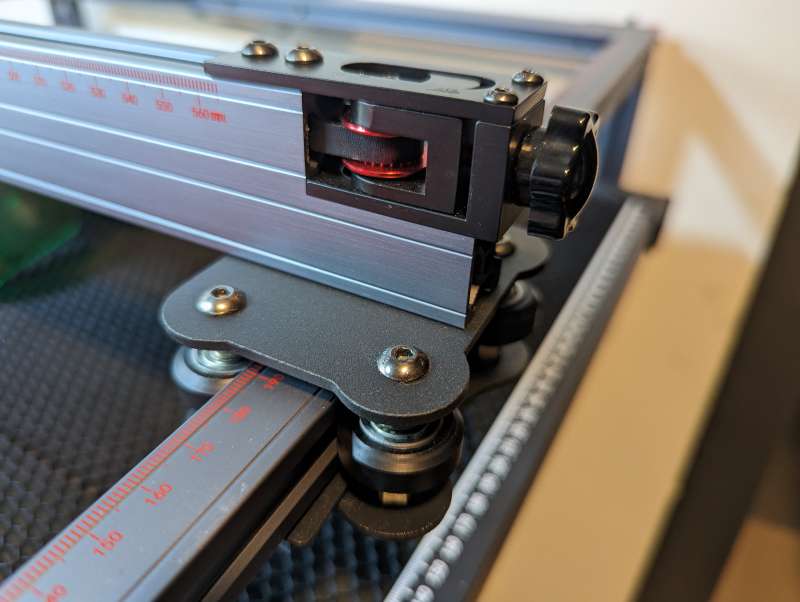
One thing to take note of after assembly is the odd-looking black tube that seems to connect to nothing. This tube connects to an optional air assist pump which can improve performance by blowing air onto the point where the laser and material surface meet.
Once the TwoTrees TS2 laser engraver is fully assembled, it’s time to move on to the software setup.
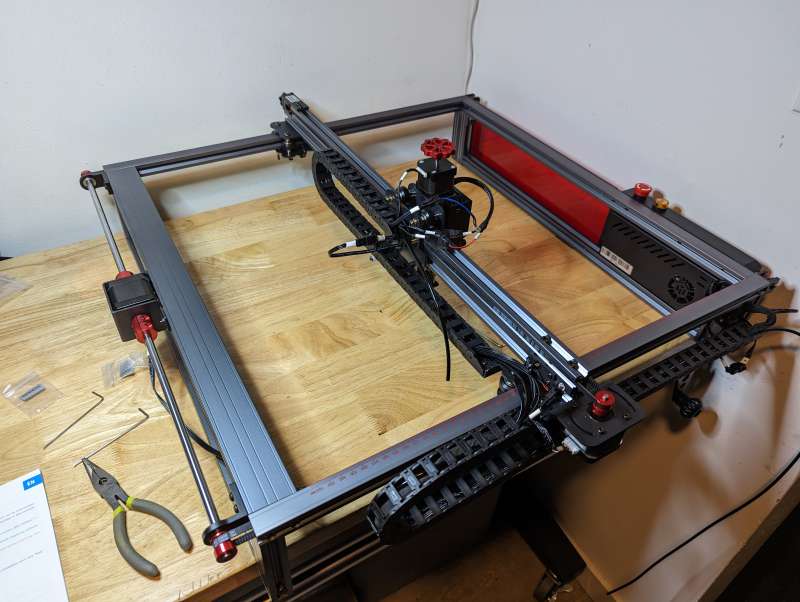
The TS2 works with a few different laser engraver programs, but TwoTrees recommends the free LaserGrbl and the purchasable LightBurn. Purchase of the TS2 does grant the user a temporary license for LightBurn.
Both programs require the TS2 to be connected to your computer via USB and they require a bit of initial setup for use with the TS2 specifically. LaserGrbl, which I used primarily, is pretty barebones and does not have as many features as LightBurn but was easy to understand after messing around with it for a bit.
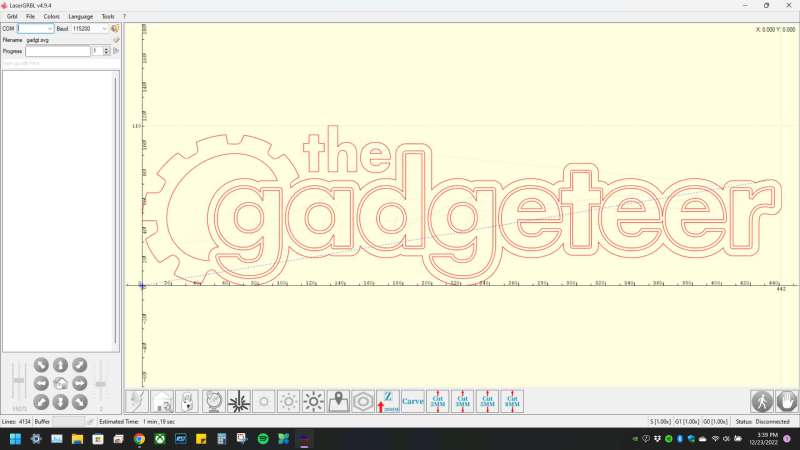
LightBurn has tons of extra features and functionality but with those comes a steeper learning curve. You can do a lot more with LightBurn though if you’re willing to invest some training time and end up purchasing a full license after the trial period is over.
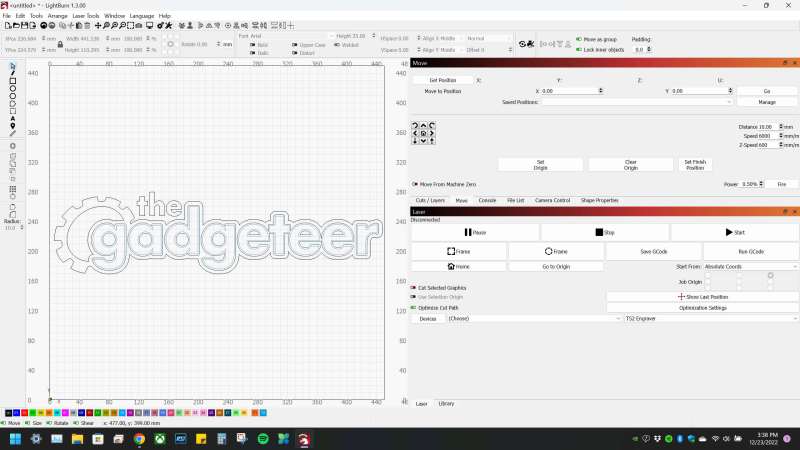
If you don’t want to be tethered to the TwoTrees TS2 laser engraver during operation, TwoTrees has an app called MKS Laser for devices that run Android or Apple iOS which controls the unit via a wireless network. I was a bit hesitant to run the TS2 from the app though because I didn’t feel I had as much control from the app as from the tethered programs. One bonus of the app though is that you can upload images right from your device and tweak them with an editor before sending them to the TS2.
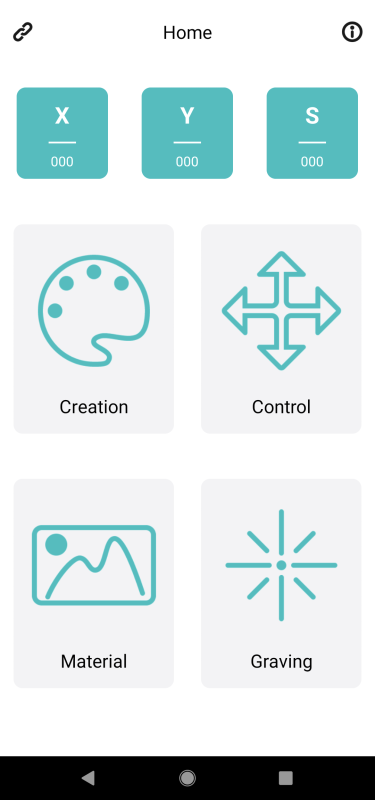
With the Ts2 and its software fully set up we can finally get to the good stuff, using the laser!
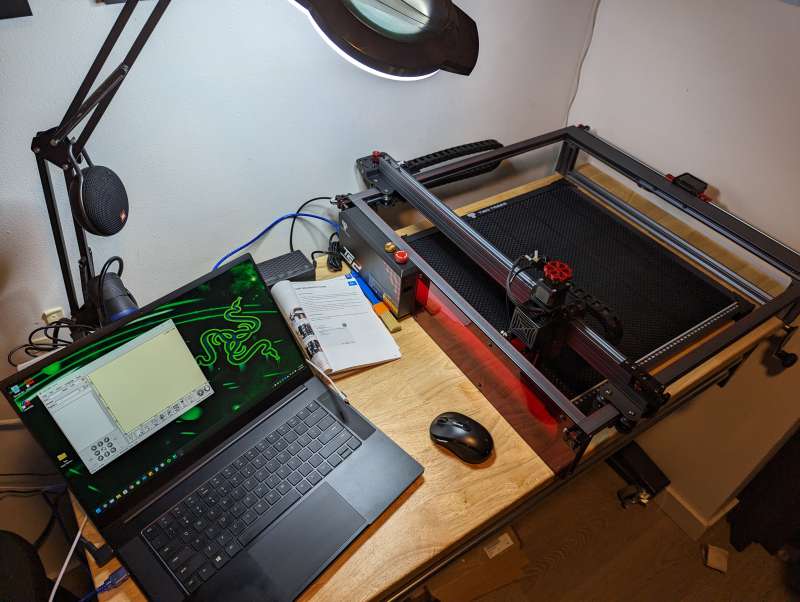
Performance
Along with the TS2, I was sent a bunch of different materials to test the unit on. Most of the materials are standard fare for laser engravers like stainless steel dog tags, wood keychains, and anodized aluminum business cards.
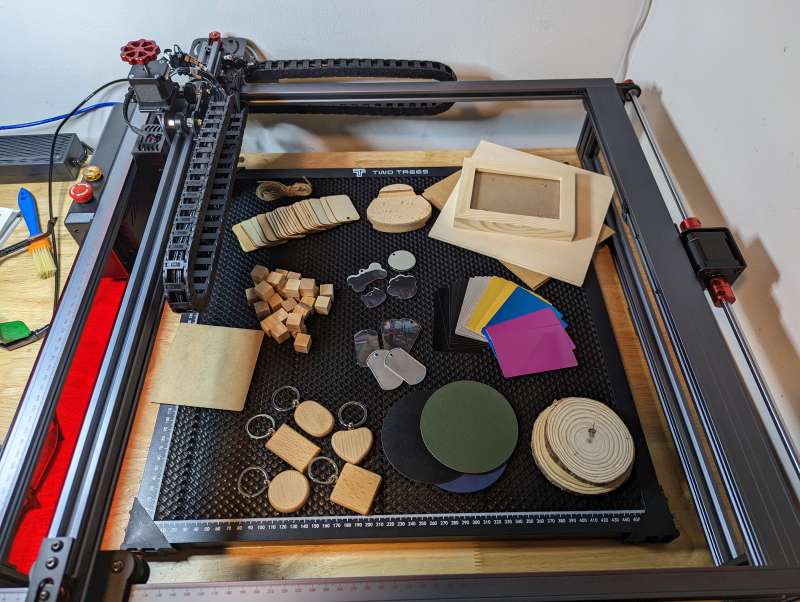
I started by loading a LaserGRBL accuracy test file which is used to check a machine’s mechanical accuracy and laser spot thickness. I used one of the non-anodized aluminum business cards for the first test.
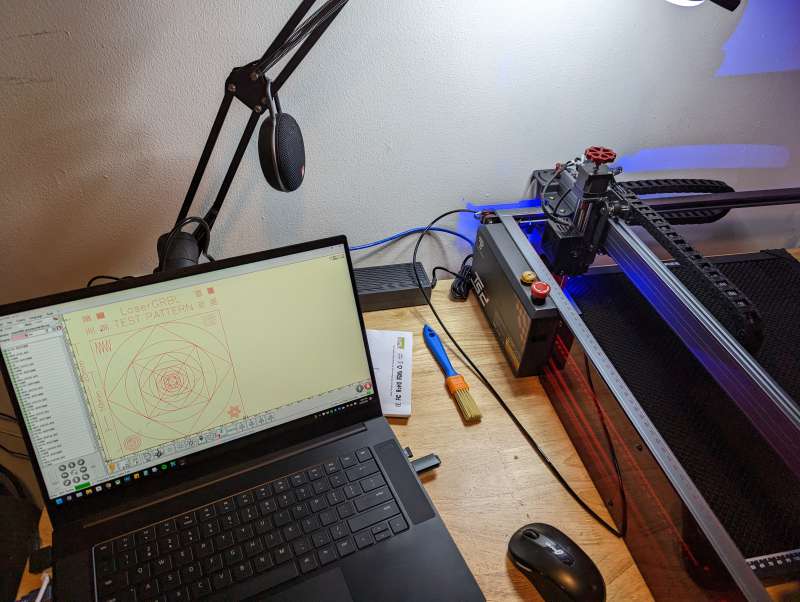
For my first test out of the box with just the default settings I was really impressed with how quickly and accurately the TS2 engraved the test file.
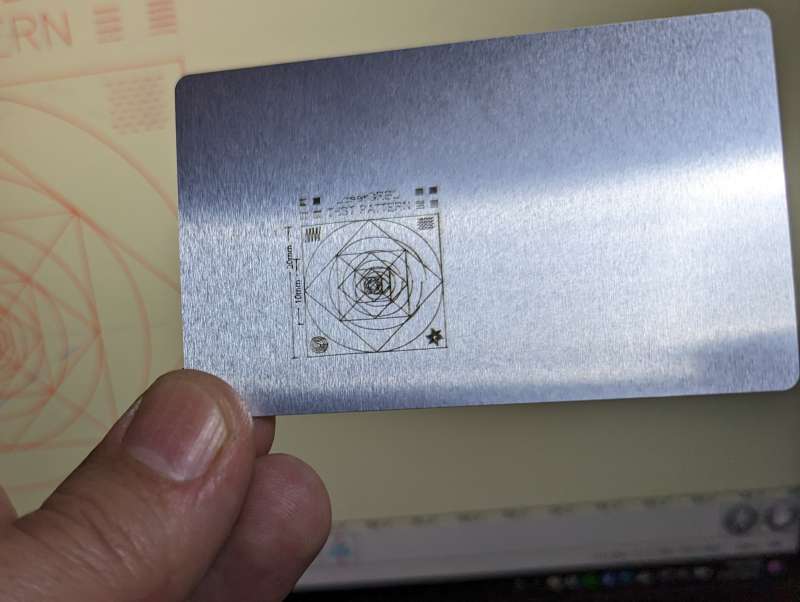
I decided to run the test file through the TS2 a few more times after tweaking the settings a bit to see the results.
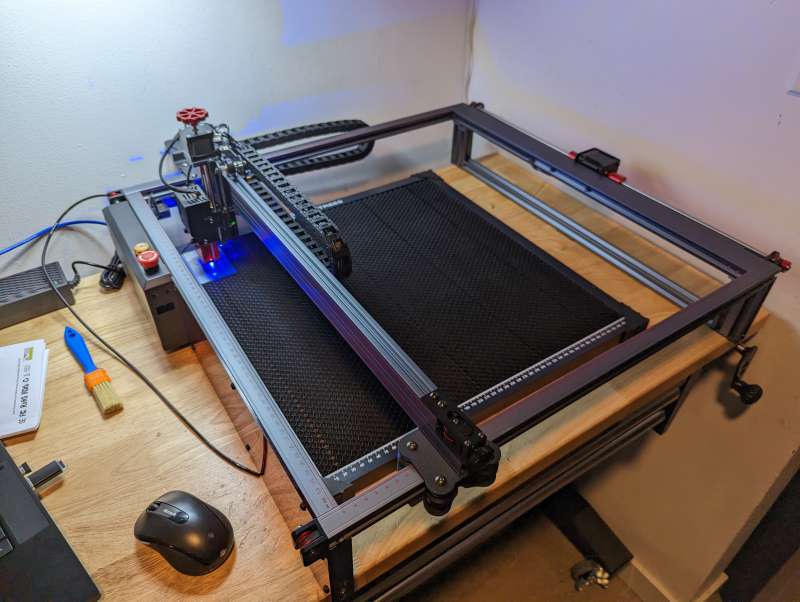
By running through a range of different settings I was able to establish a good baseline for what worked best for the TS2 and what produced poor results.
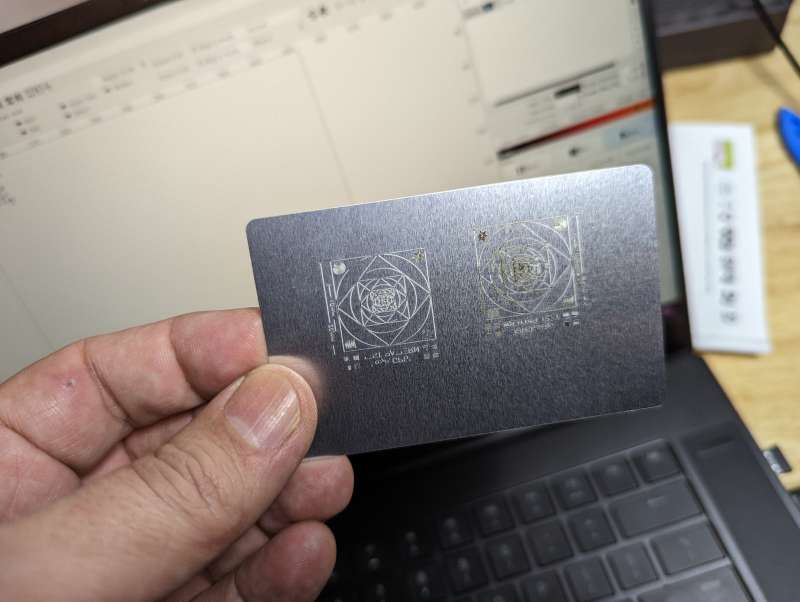
The next test was to reproduce the TwoTrees logo that’s included on the Micro SD card that ships with the TS2.
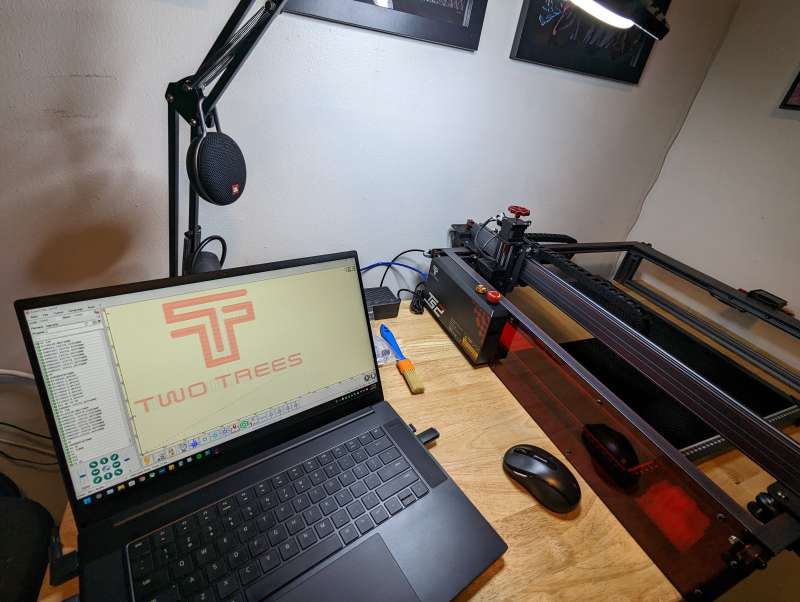
I loaded the logo into LaserGrbl and adjusted the size a bit so it would take up a large section of some thin Kraft cardboard.
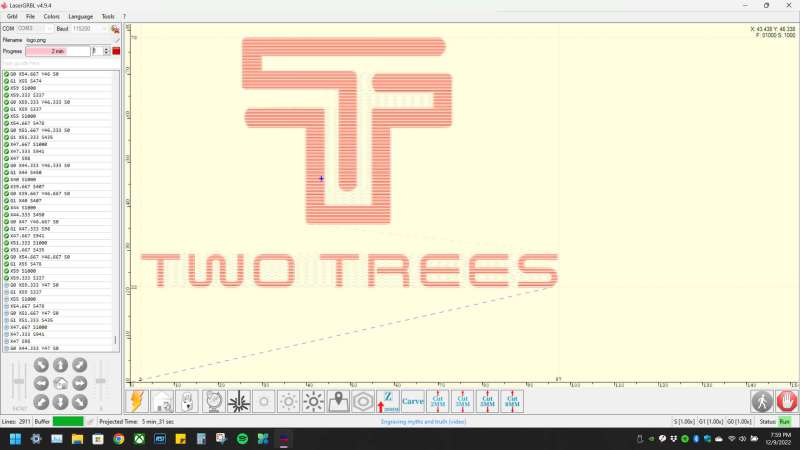
I adjusted the laser to an intensity and speed I hoped would just burn the logo’s image onto the cardboard.
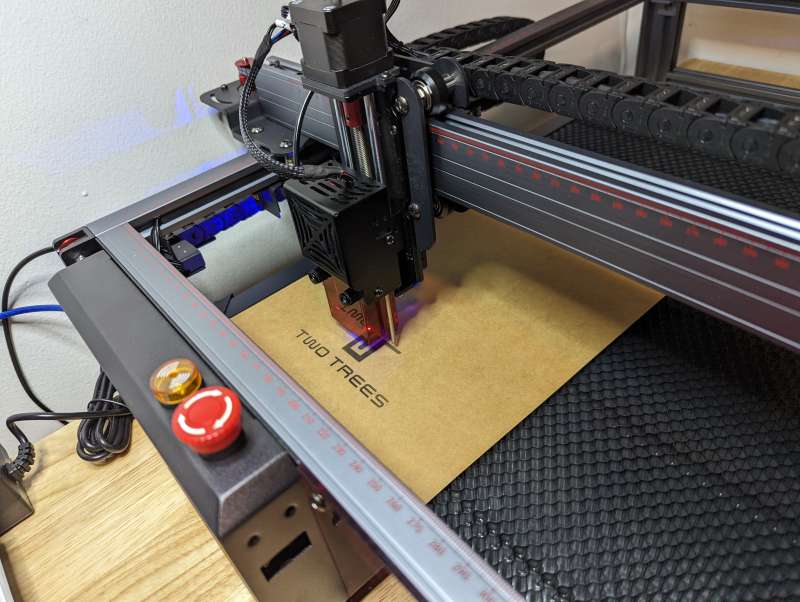
The reproduction of the logo was pretty good, although the scan lines of the laser were quite visible.
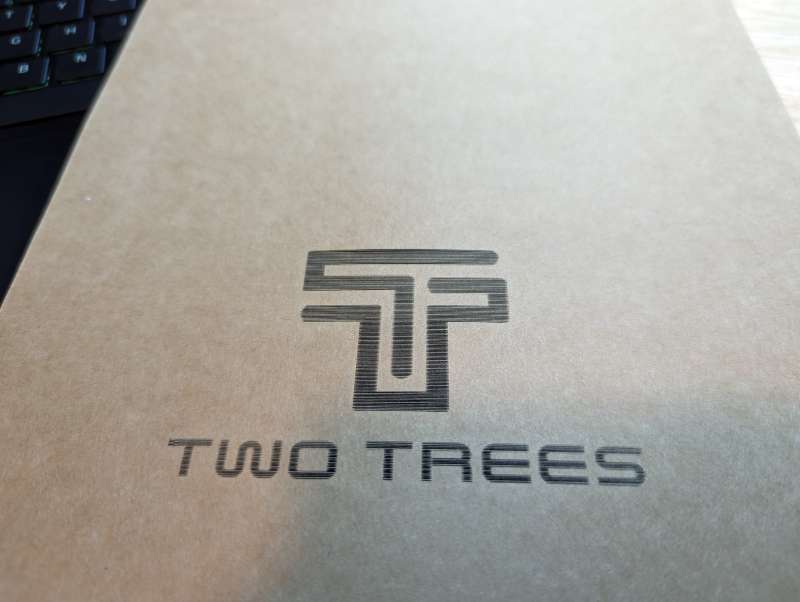
I also set the intensity a bit too high so instead of just burning the image onto the cardboard the laser cut right through it in many places.
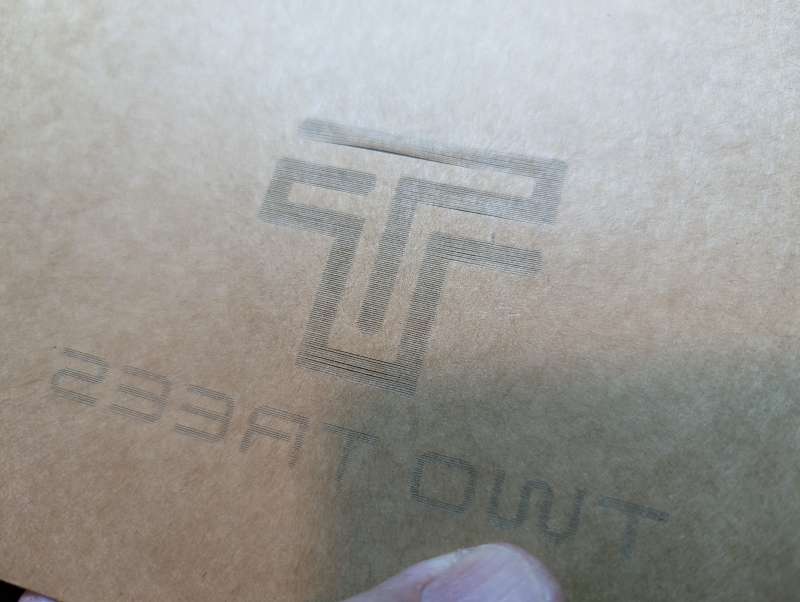
I adjusted the settings a bit more and decided to let the laser really show its stuff and cut out a logo from the Kraft cardboard.
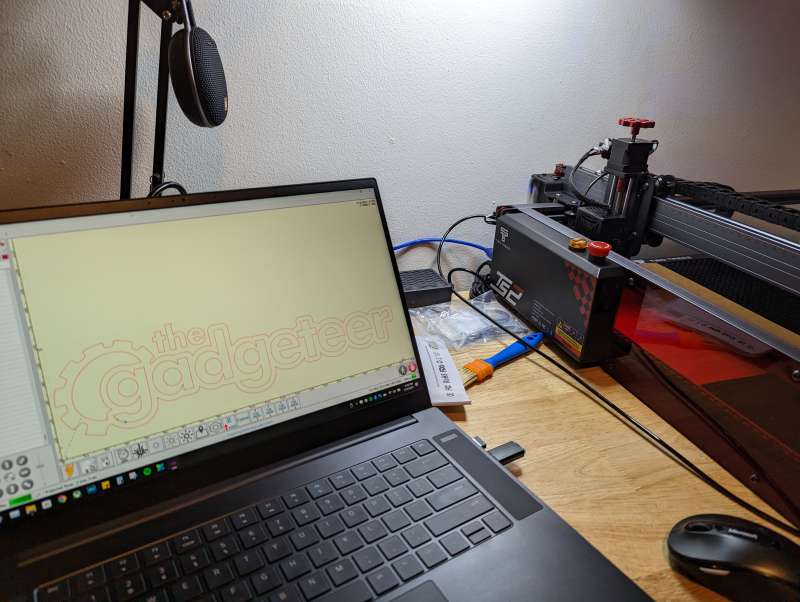
I loaded up the Gadgeteer logo and increased the size to take up the full length of the Kraft cardboard sample.
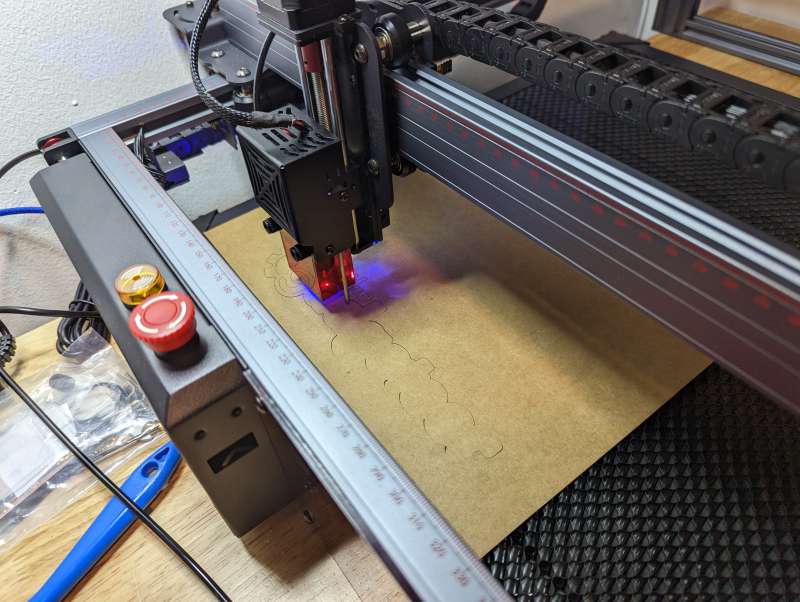
The TwoTrees TS2 laser engraver made quick work of the job, easily slicing through the cardboard and perfectly reproducing the logo.
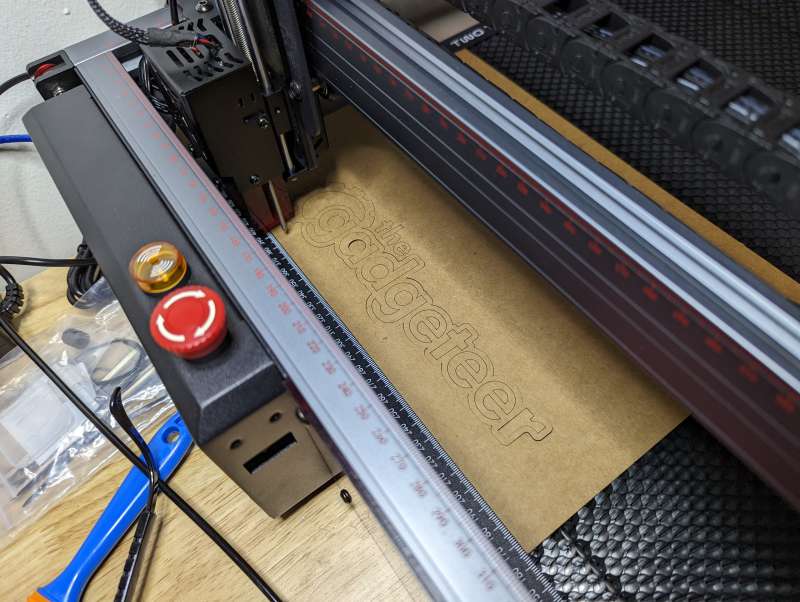
Unfortunately, I didn’t really think this project through and all of the pieces of the logo were cut out, even the negative space within the letters. So it was a success for the TS2 and a failure for my laser-cutting skills.
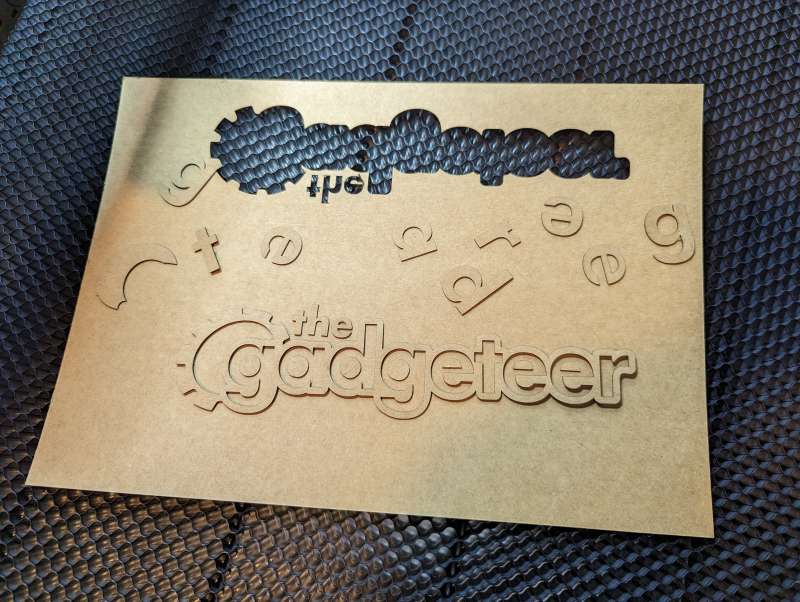
I didn’t give up though, I figured the logo would work much better as an engraving, so I calibrated the laser to work on a thin aluminum business card.
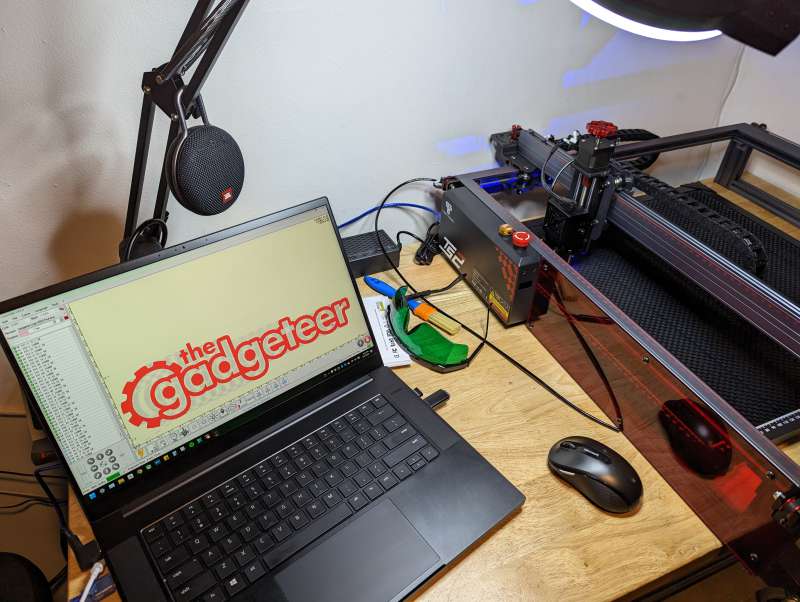
The TS2 really impressed me with the engraving on the metal card. The settings and focus were perfect for burning the logo into the aluminum card with sharp edges and a dark interior color.
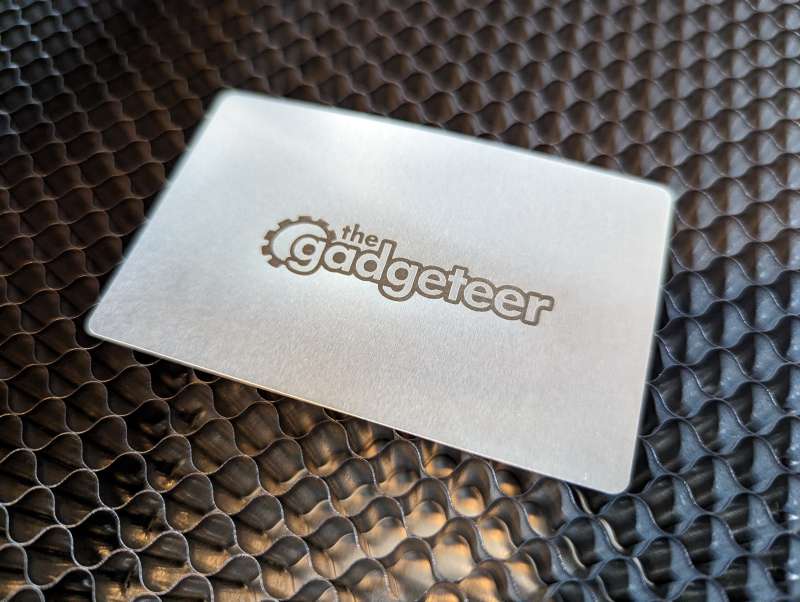
Once again though I got a bit overzealous and tried to reproduce the same results on a wooden dog tag. Needless to say, I quickly found out that the settings for aluminum are not transferable to wood. This was a great test of the TS2’s smoke and fire alarm as well as my apartment’s smoke alarm.
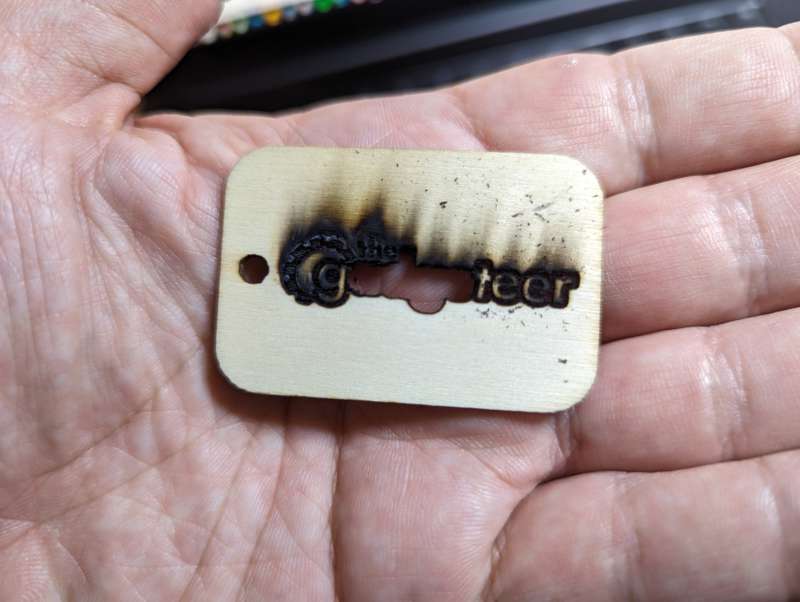
By dialing the laser intensity back a bit and increasing the speed I was able to get a great engraving on the second try.
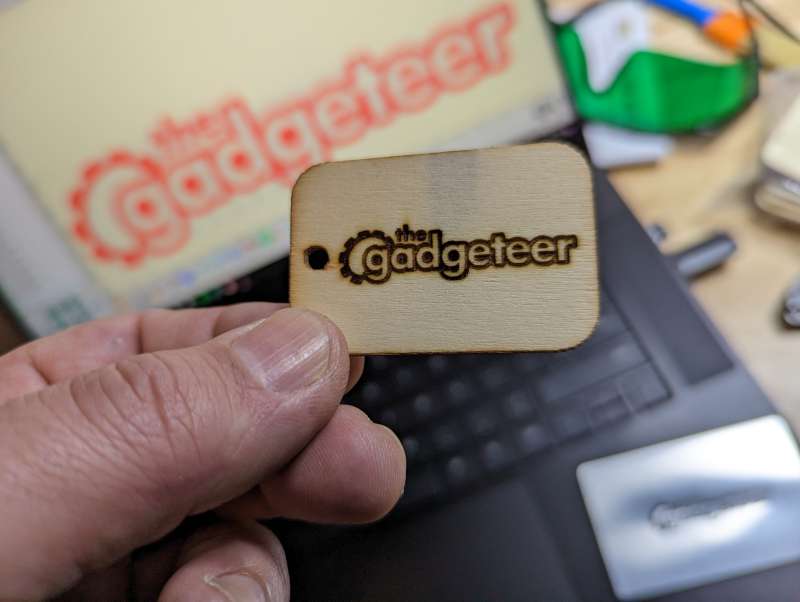
I kept those same settings to try engraving the logo onto a much bigger piece of Basswood Plywood.
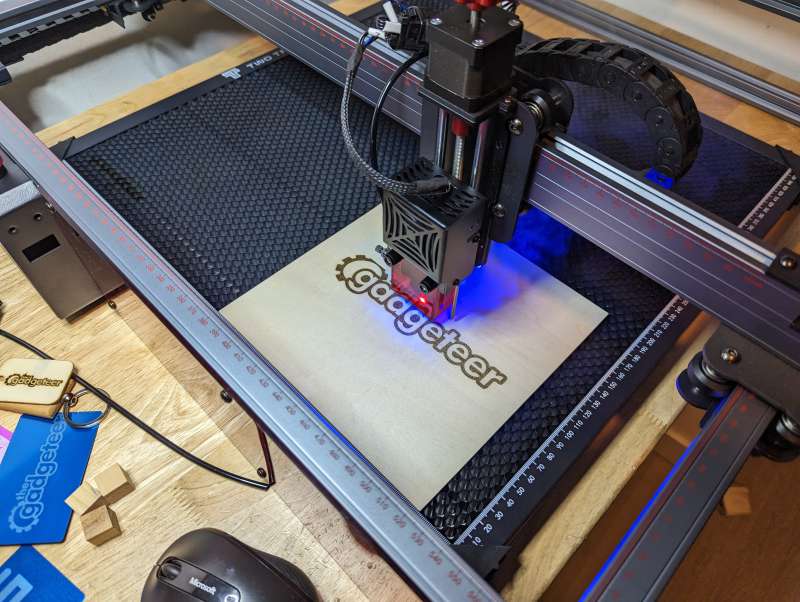
The TwoTrees TS2 laser engraver quickly burned the enlarged logo onto the plywood with no problem. Although I did notice that I was now able to see the scan lines in the logo on closer inspection. I think this could be fixed by slowing the speed down just a bit.
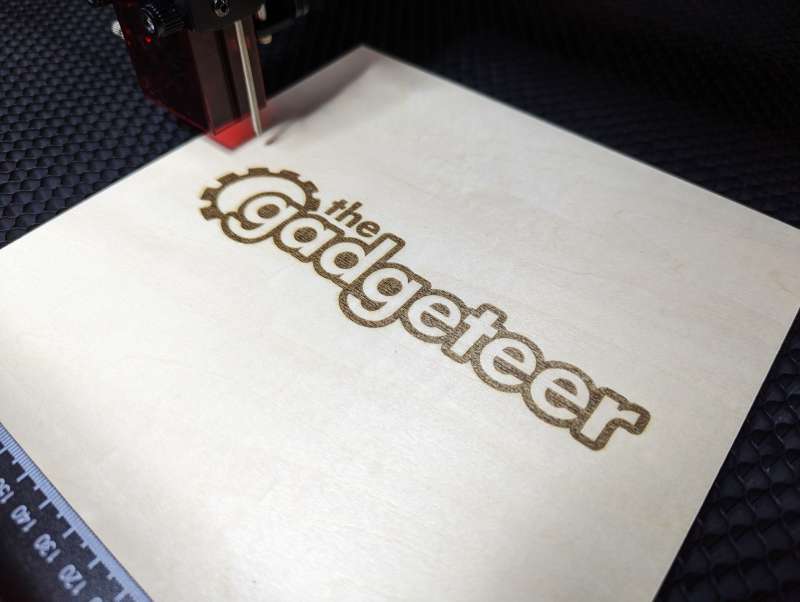
Since the Gadgeteer logo was working so well I continued testing it on different materials and at varying sizes.

My favorite engraving was on the blue anodized aluminum business card. The laser burns away the anodization and it gives the logo a great metallic color.
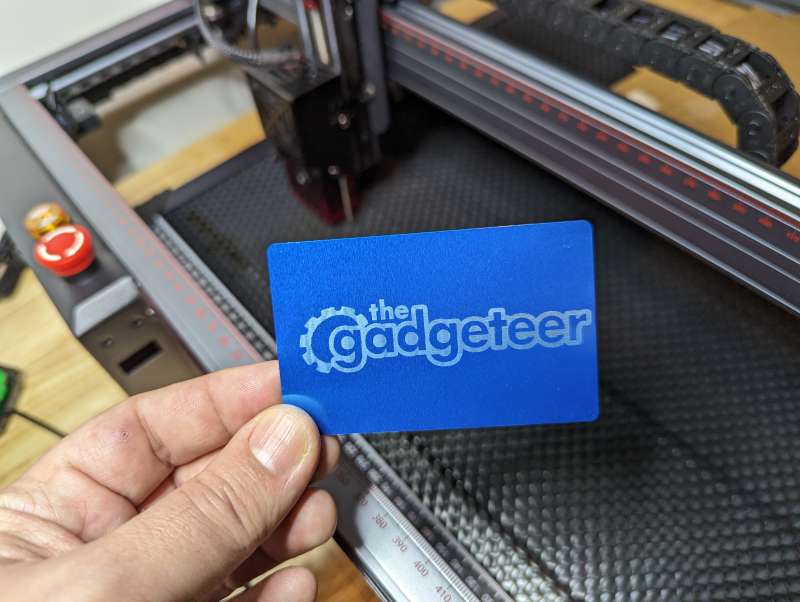
I used a vector version of the Gadgeteer logo and that’s what seems to produce the best results. Vector images are able to be enlarged in programs like Adobe Illustrator without ever losing resolution since the information that makes up the image are simple points and lines instead of individual pixels like a raster image.
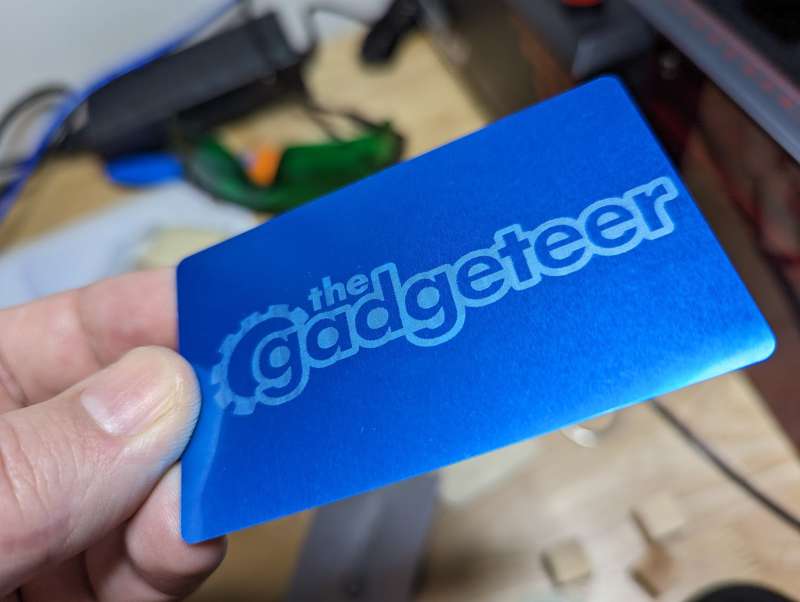
For my last logo test, I tried shrinking the logo down to fit on a small wood keychain.
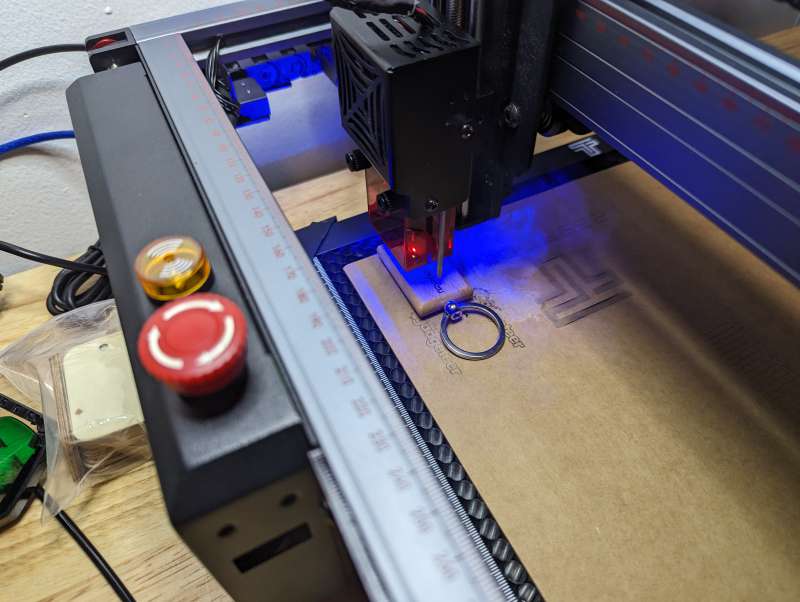
Lining up the tiny keychain under the laser was the most difficult part of this job, so I used some scrap material to make sure everything would work on the first pass. After a few tries on the scrap material, I was able to get a great engraving on the keychain. The dark color of the burn on this wood really makes the logo pop.
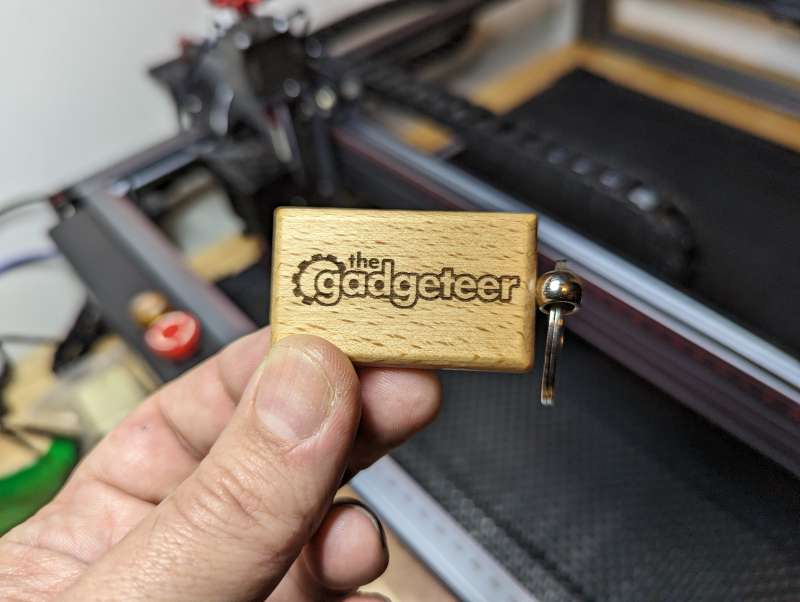
For the last round of testing of the TS2, I pumped up the power on the laser to cut out some pieces of the Basswood Plywood to make a small box. There are tons of models like this available for free online. I used a web app that helps you to design a box to your specification and then save the model for cutting.
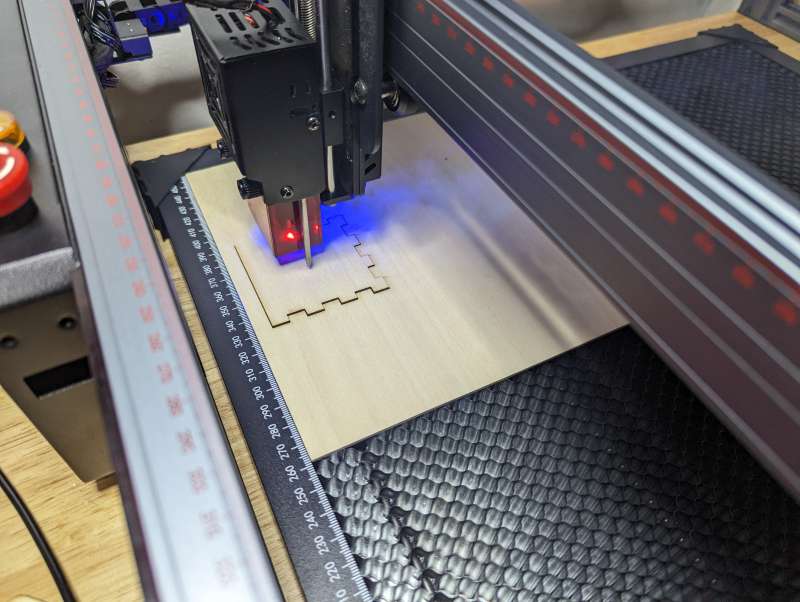
The thin plywood was no match for the 10W laser of the TS2 and the app designed a box that fit together perfectly. I didn’t have enough sample material to make anything more complex, but I’m confident the TS2’s cutting ability could handle more interesting pieces.
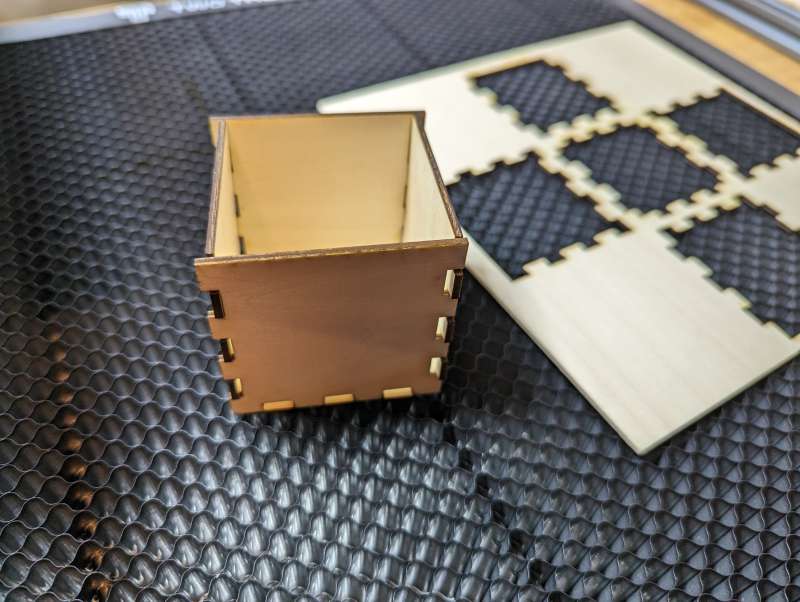
Overall the thing that impressed me most about the TS2 was the speed. This may just be because I am used to the glacial pace of most 3D printers though. The TS2 with its extensive safety features, autofocusing laser, and huge work area really won me over on laser engraving. For first-time laser enthusiasts who are more advanced hobbyists, I think the TwoTrees TS2 laser engraver would be a great addition to any workshop.
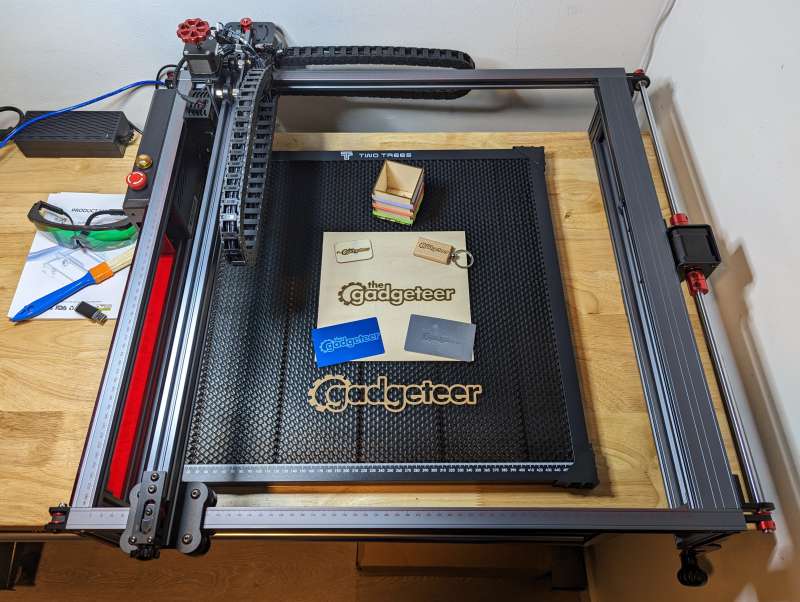
What I like
- Extensive safety features such as protective covering on side of the unit as well as around laser
- Autofocus feature takes the guesswork out of using different materials
- Expanded working area is very useful for bigger projects
What I’d change
- Very poor instructions for setup, software, and operation.
- Arrived with a damaged connection
- Frustrating assembly
Final thoughts
Even though the TwoTrees TS2 10W Diode Laser Engraver is my first foray into laser cutting and engraving I was able to successfully complete a bunch of fun projects after a bit of trial and error. There are some minor issues with the TS2’s horrible instructions and the assembly can be very frustrating. Once assembled though the TS2 performed reliably using the free LaserGrbl software. The large work area adds to the versatility of the TS2 and the auto-focusing 10W laser takes a lot of guesswork out of using different materials. The $569 price might seem a bit high, but that powerful 10W laser along with the extra safety and focusing features are worth it. If you need a laser engraver slightly more advanced than an entry-level model, the TwoTrees TS2 10W Diode Laser Engraver is a great choice.
Price: $669.99
Where to buy: TwoTrees (Save up to $40 with discount code:GG40 expires 11/6/23) and Amazon
Source: The sample of this product was provided by TwoTrees.


![[Strong Magnetic Lock]:Built-in magnets, offering a magnetic force of up to 3000g. Ensures the magnetic wallet fits tightly and attaches securely to the back of your iPhone. [Smart Card Storage]:The magnetic wallet is designed ingeniously to hold 5 c...](https://m.media-amazon.com/images/I/41i8zbilqXL._SL160_.jpg)